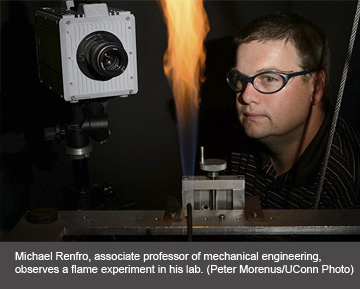by Colin Poitras, UConn Today
 From Igor Sikorsky’s first American helicopter to Pratt & Whitney’s latest engine for the nation’s new Joint Strike Fighter jet, Connecticut has a proud history of aviation science innovation.
From Igor Sikorsky’s first American helicopter to Pratt & Whitney’s latest engine for the nation’s new Joint Strike Fighter jet, Connecticut has a proud history of aviation science innovation.
At UConn, researchers are doing their part by supplying Connecticut’s robust aerospace industry with innovative technologies to support a new generation of faster, more efficient, and more reliable aircraft demanded by commercial airlines and the U.S. military.
One of those scientists is Michael Renfro, UConn’s United Technologies (UTC) associate professor of engineering innovation and associate head of the Department of Mechanical Engineering. Renfro specializes in optical laser diagnostics.
Renfro and one of his research partners, Baki Cetegen, UTC chair professor and head of UConn’s mechanical engineering department, are using laser-based measurement tools to maximize the performance and stability of jet engine combustors. The research team is using similar laser diagnostic technology to better understand the basic science behind flame propagation, extinction, and instability in order to improve jet engine design.
Please read the full story here.



